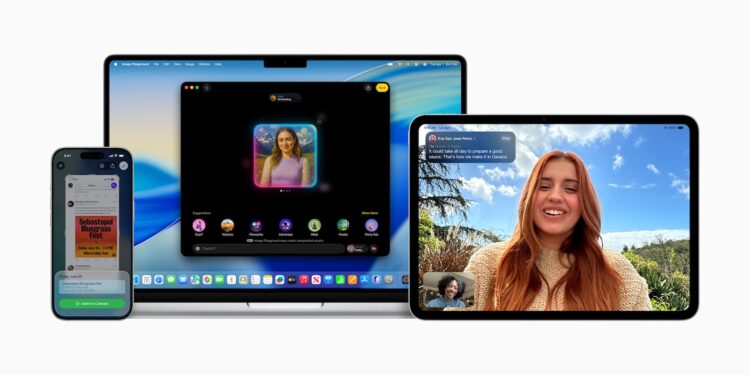When it comes to artificial intelligence, names like OpenAI, Google, and Meta currently dominate the headlines. Apple, on the other hand, seems rather reserved at first glance. But appearances are deceptive. In a rare interview, two high-ranking Apple executives discuss how the company is using AI – and why it isn't simply jumping on the same bandwagon as its competitors.
Joanna Stern of the Wall Street Journal spoke with Craig Federighi, Apple's software chief, and Greg Joswiak, the company's chief marketing officer, about Apple Intelligence. In their conversation, they provide unusually candid insights into Apple's strategy. It becomes clear that Apple is deliberately pursuing its own path. Instead of relying on a large, publicly visible chatbot, the company is working on an AI that operates quietly in the background—but is deeply integrated into the operating system. Apple follows a different logic than many of its competitors.
Apple Intelligence is not a product, but part of the system
Greg Joswiak emphasizes that Apple Intelligence isn't a standalone app. There's no visible entry point, no chatbot button, no platform with a logo. The AI is designed to work in such a way that you don't even actively perceive it. It's embedded in iOS, iPadOS, and macOS and supports you in everyday situations—without you feeling like you're interacting with AI. According to Joswiak, this is the big difference between Apple and the competition. Others build individual applications around AI, while Apple sees it as a basic function, similar to copy and paste or the share menu. The goal is to use the technology where it actually makes your everyday life easier.
Siri should become more context-related
Craig Federighi adds that Siri will be more context-sensitive in the future thanks to so-called app intents. This means the voice assistant can access content from specific apps and better understand what you're trying to achieve. If you want to schedule an appointment or create a reminder, for example, Siri can incorporate relevant information from Calendar, Mail, and other apps. According to Federighi, these functions are already in use internally – what was shown in demos is not theory or "demoware." Joswiak explicitly contradicts the impression that Apple has presented something that doesn't yet work. In doing so, he is also indirectly responding to critical comments from the tech scene, including from John Gruber of Daring Fireball.
Apple deliberately refrains from having its own chatbot
When asked why Apple didn't develop its own chatbot, Joswiak answers clearly: Apple deliberately didn't build a ChatGPT competitor. Instead, they're focusing on integration. Apple users should be able to access ChatGPT via the operating system—because OpenAI offers the best solution here. But Apple doesn't want to develop a new chatbot product itself just to be there. Federighi draws a comparison: Nobody is asking Apple to build its own shopping portal like Amazon or a video network like YouTube. So why a chatbot? Apple doesn't see its role as being everywhere, but rather where it can offer real added value.
Privacy and on-device processing are paramount
Another central point in Apple's strategy: data protection. Apple Intelligence runs largely directly on the device. This means your data never leaves your iPhone or iPad. Unlike many other AI solutions that use cloud data centers, Apple places great importance on processing sensitive information locally. This also applies to third-party developers. Apple is opening up its Foundation Models framework to developers so they can integrate AI functions locally on the device without having to send data to external servers. This not only reduces data protection risks but also reduces dependence on external providers.
Apple is pursuing a different pace – and a different goal
Although Apple doesn't currently have a major AI product on the market, that doesn't mean they're lagging behind. Their strategy is long-term. Apple doesn't want to release half-finished features; instead, they wait until the technology is mature and can be seamlessly integrated into users' everyday lives. The company has acknowledged criticism of current Apple AI features, such as weak image generators in Image Playground or Siri's occasional lack of understanding of calendars. But instead of using force to force the issue, Apple is taking a step back, testing, and systematically developing further.
- The difference to the competition: While others are experimenting with large language models that require enormous computing power and often a lot of user data, Apple is working on a model that is resource-efficient, data-secure and individually tailored.
Apple relies on quiet intelligence instead of AI show
Apple isn't lagging behind in the AI race—it's just running on a different track. No showcases, no experiments, no beta features for the mass market. Instead: integration, privacy, and everyday utility. Apple Intelligence isn't intended as a product, but as part of the infrastructure. If you use Apple, you'll be using AI features in the future without even realizing it. And that's precisely the intention behind it. Less noise, more substance. (Image: Apple)
- Xcode 26 brings AI freedom: ChatGPT, Claude & more
- Xcode 26: Leak points to affordable Apple Vision Headset
- Apple Notes comes to Apple Watch with watchOS 26
- Apple makes Image Playground really strong with ChatGPT
- iOS 26 & Co.: These Apple devices will receive updates
- iOS 26 explained: Why iOS 18 will not be followed by iOS 19
- watchOS 26 – All new features at a glance





